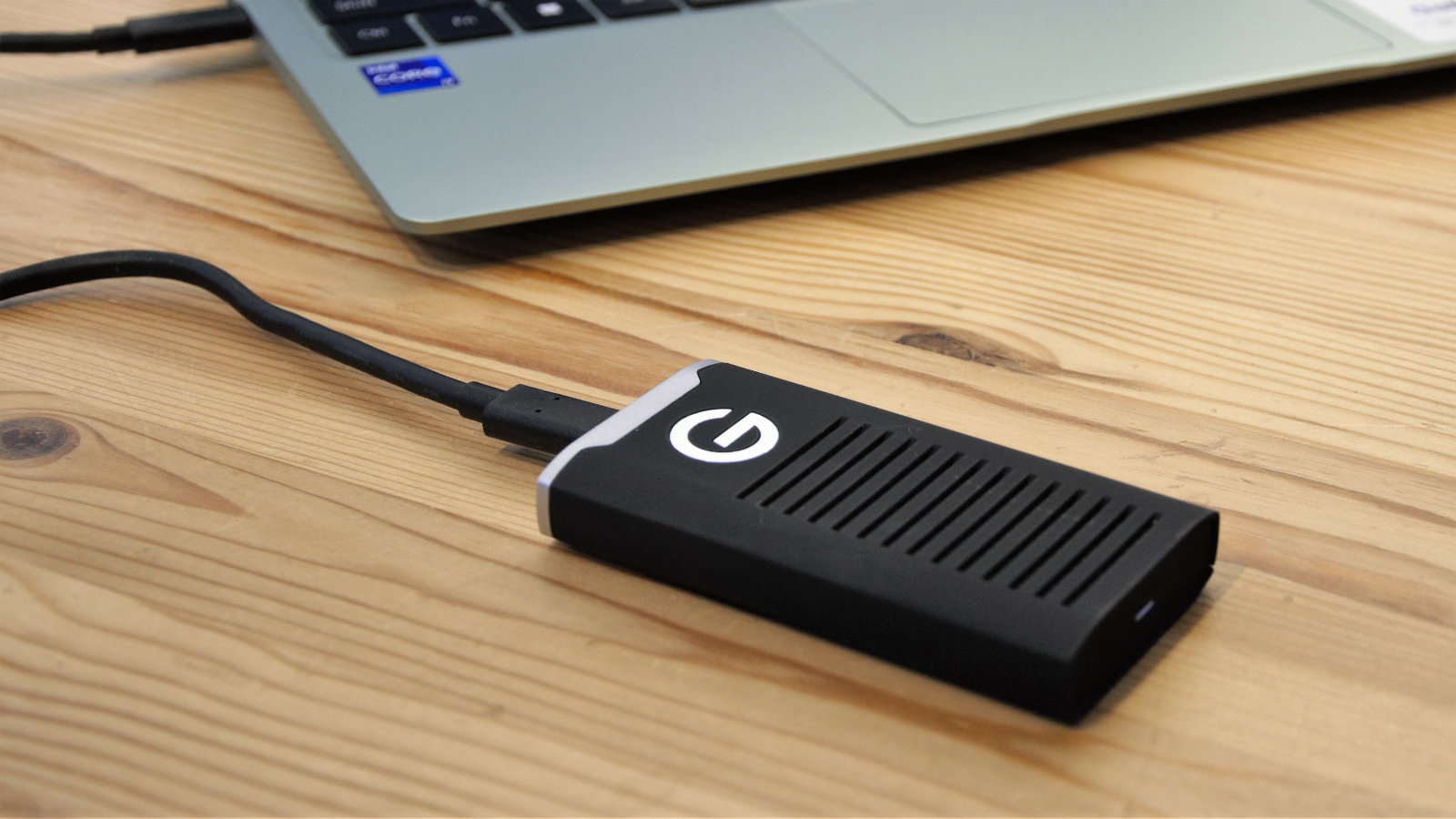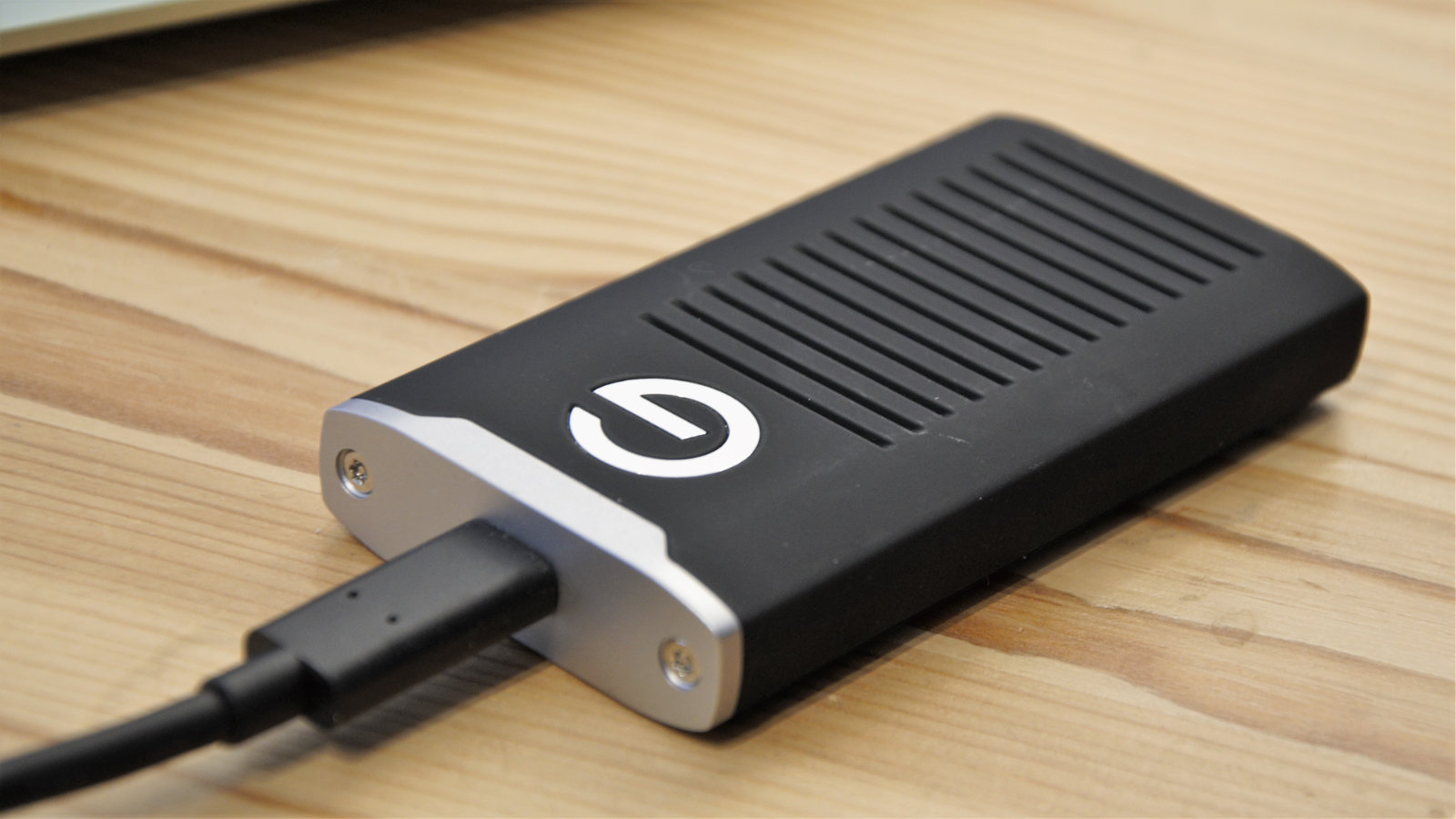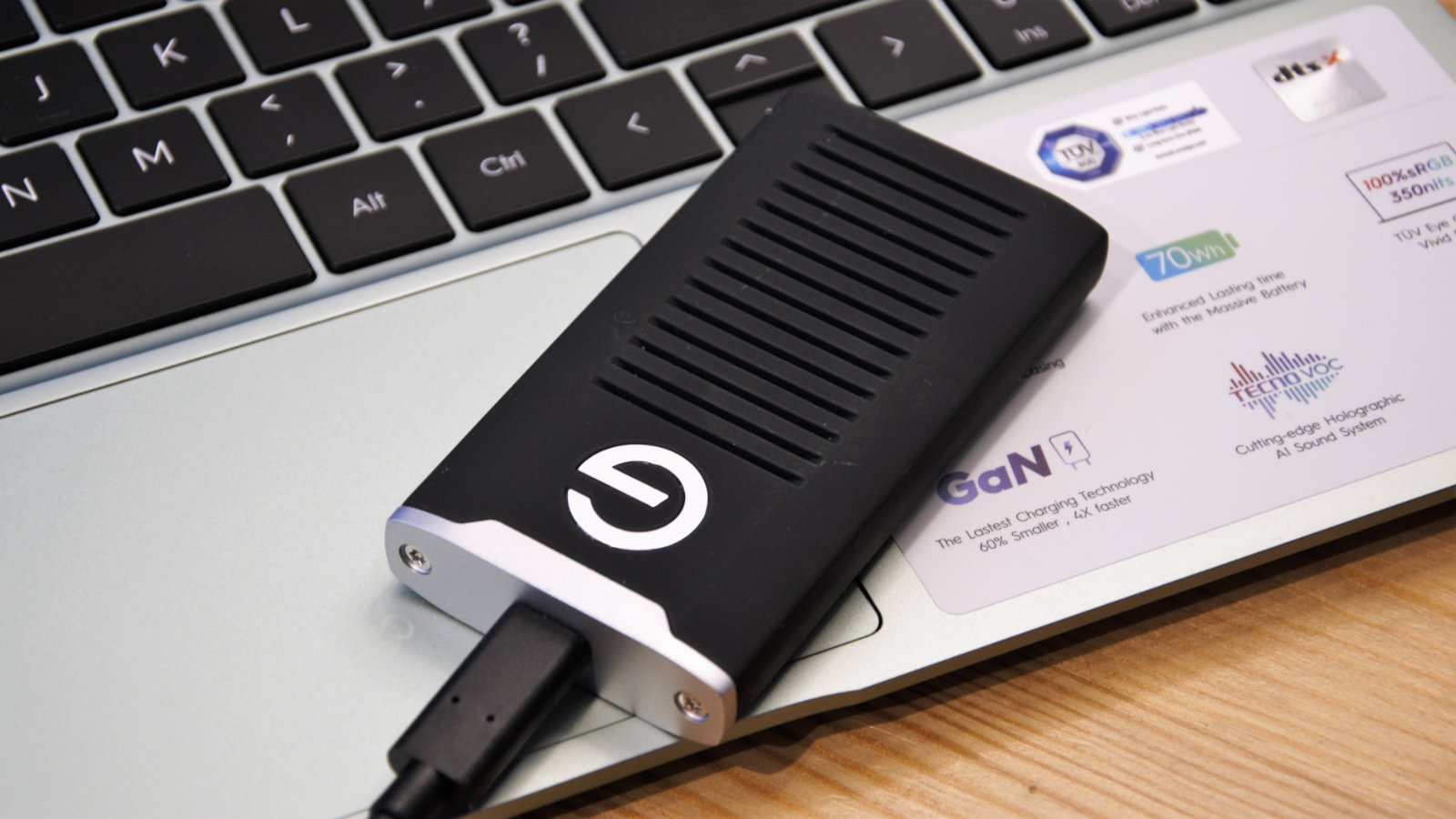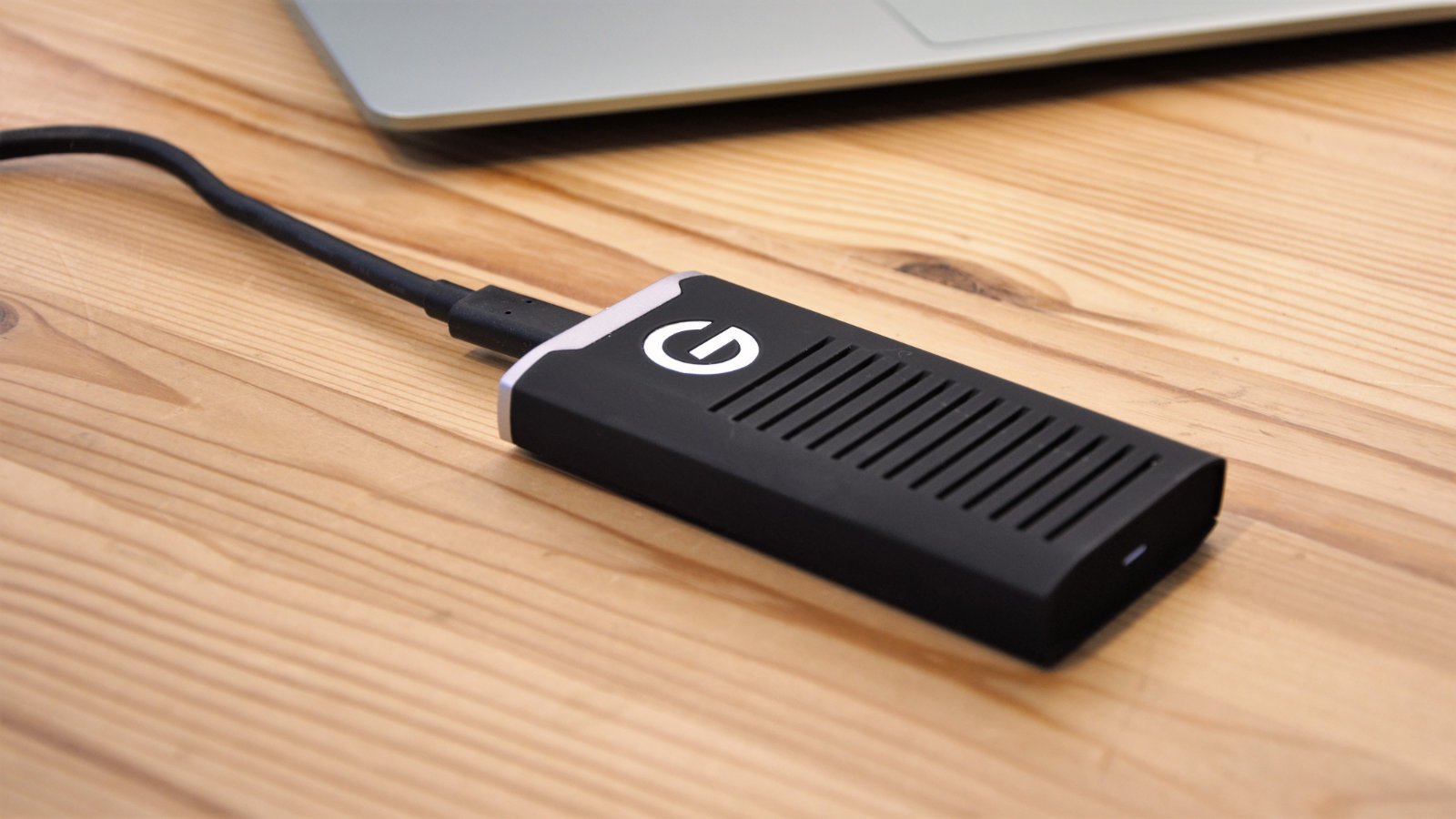TechRadar Verdict
A beautifully made drive can easily fit in a pocket with the cables detached. It has both USB standard cable types but no carry pouch or software utilities included. The high price is a little offset by the IP67 rating and the support for hardware encryption.
Pros
- +
Both USB-C and USB-A cables
- +
Tough IP67 Rated enclosure
- +
Hardware Encryption
Cons
- -
Expensive
- -
No software
- -
Pre-formatted for Apple Mac
Why you can trust TechRadar
SanDisk Professional G-DRIVE SSD: Two minute review
Interface: USB 3.2 Gen-2 (10Gb/s)
Capacities: 500GB, 1TB, 2TB and 4TB
Casing material: Aluminium and TPU
Quoted Speeds: 1050MB/s read and 1000MB/s write
Operating temperature: 5-35C
Warranty/support: limited 5-year warranty with free technical support
Compatible with: macOS 10.13+ (Time Machine compatible), Windows 10+ (via reformat)
Encryption: 256-bit AES-XTS hardware encryption
Dimensions: 90 x 50 x 15 mm
Default format: APFS
Weight: 90 g
Warranty: 5-year limited
Box Contents: G-DRIVE Desktop Drive, PSU, USB-C to USB-C Cable, Quick Start Guide
The transition to SSD drives from conventional hard drive storage has been a gradual one. But with the limits of 2.5-inch drives being about 5TB currently, the SSD looks likely to overtake legacy technology this year in both speed and available capacities.
The G-DRIVE range of external SSDs, under the SanDisk Professional branding, offers a selection of robust external drives ranging in size from 500GB to 4TB. And, of these, the SanDisk Professional G-DRIVE SSD is the lowest rung on this ladder.
Where other drives offer Thunderbolt technology, this drive is exclusively USB 3.2, and the best port for it is one with USB 3.2 Gen 2 level bandwidth.
The drive is contained within a block of milled aluminum covered in a TPU skin, providing a useful level of durability and water/dust resistance. According to SanDisk, the protection is IP67 standard (not water submersion), and the enclosure can withstand 2000lb of crushing force alongside a drop of 3M onto a carpeted concrete floor.
The PRO-G40 from the same source has higher crush resilience and IP68 dust/water resistance, but the G-DRIVE SSD should be able to handle some knocks and environmental encounters. Though, this isn’t a device we’d take swimming.
Included in the box are two 50cm cables, one each for USB-C and USB-A connections, allowing it to be connected to most computers that support USB.
While it will work with USB 2.0 and USB 3.0 (aka USB 3.1), to get the best transfer speeds from it requires a port with USB 3.2 Gen 2 10Gbit/s.
Sign up to the TechRadar Pro newsletter to get all the top news, opinion, features and guidance your business needs to succeed!
For those that own an Apple Mac, just connect the drive and then use it to manually copy files or configure it for Time Machine use.
As it comes pre-formatted for Apple APFS, Windows PC owners will need to understand how to use the Management Console and volume management to reformat the drive to a file system that Windows will understand.
That SanDisk doesn’t include any cross-system boot sector with a utility to configure the drive for any OS is disappointing, and they also provide no software for this drive or others in the same range.
Considering the cost of this hardware, it is remarkably short on added value.
One area it does shine is that the NVMe inside has the capability for 256-bit AES-XTS hardware encryption, enabling the contents of the drive to be secured effectively.
Though, the owner must provide encryption tools to lock and subsequently unlock the contents stored on the drive, if they want to use this functionality.
SanDisk Professional G-DRIVE SSD: Price and availability

- How much does it cost? From $94.99 / £138.99
- When is it out? It is available now
- Where can you get it? Widely available from the larger online retailers in most regions and directly from Western Digital.
Bought directly from the makers, the 500GB, 1TB, 2TB and 4TB are £138.99, £227.99, £356.99 and £673.99 in the UK. In contrast, US customers are offered the same capacities for only $94.99, $129.99, $209.99 and $429.99.
Based on current exchange rates, UK customers pay, on average, between 80% and 120% more for the same capacity directly from Western Digital.
Even with VAT factored in, UK customers are getting a remarkably raw deal. And online retailers such as Amazon aren’t undercutting Western Digital by any significant amount.
And for those wondering if this high pricing is Brexit related, it isn’t. The prices for this range in France are equally inflated, being €163.99, €264.99, €410.99 and €769.99.
Since this drive is only USB Gen 3.2 Gen 2 capable, there are many brands and products that offer the same capacities and performance levels for significantly less.
A good example is the Crucial X8 4TB, a similarly robust design with similar performance over USB. In the UK, this costs £274.58, including VAT, and in the USA, it's $279.99. And Crucial also makes the X6 which is ten dollars cheaper for the same 4TB of space.
That you can buy two Crucial X8 for the price of a single SanDisk Professional SSD that isn’t any faster suggests that either Crucial is underselling its line or SanDisk has entirely lost the pricing plot.
Making it somewhat water/dust resistant and hardware encryption doesn’t justify more than doubling the cost, unfortunately.
- Value: 2 / 5
SanDisk Professional G-DRIVE SSD: Design

- Tough enclosure
- Both USB-C and USB-A cables
- No carry case
The milled aluminum and rubberized coating provide a sturdy home for the NAND module mounted inside the SanDisk Professional G-DRIVE SSD.
Given the IP67 rating, it should handle the odd splash of water, being dumped in the dust and, with 2000lb of crush resistance, accidentally driven over by a family car.
One curiosity is that the drive can supposedly handle being dropped 3 metres, but in the fine print, that’s onto concrete covered in carpet. The carpet requirement seems to be something of an odd detail, as the world wasn’t fully carpeted when we looked last.
Where this drive is better than the more expensive PRO-G40 is that it at least comes with both the USB cables most customers will need, and they are also a decent length.
But the same as that counterpart, SanDisk doesn’t provide a pouch or case to carry the drive and its cables, a niche that some third party will undoubtedly fill.
The only feature of the drive is a small white LED on the bottom that flashes to indicate activity, and that’s the only detail.

For those wondering if the enclosure could be repurposed, there appears to be no obvious way inside. And, while it might be possible to dismantle, there are no guarantees that the NAND flash module inside uses a standard M.2 slot.
But we can say with some certainty that any attempt to open it would immediately invalidate the five-year limited warranty.
Overall, this is a very nicely engineered and constructed external drive that looks able to cope with abuse that might be expected to kill those external SSDs that are made mostly of plastic.
- Design: 3 / 5
SanDisk Professional G-DRIVE SSD: Features
- Up to 4TB options
- Apple Pre-formatted
- No software
Probably the best aspect of this design is the available capacity, as many of the other SanDisk Professional SSDs are capped at 2TB, where 4TB of storage is available.
For those purchasing the G-DRIVE SSD for their Apple Mac, all they need to do is connect it to a recent Apple Mac computer, as the drive is pre-formatted with APFS.
Microsoft Windows-using customers will need the technical knowledge and confidence to use the Windows management console to delete the existing partition and create a new NTFS or exFAT volume.
Why they didn’t use exFAT and a utility that runs on both platforms to reformat the drive for both groups is a mystery. Because that’s normally what Western Digital does, the overarching business that owns the SanDisk brand.
What Western Digital also usually provides with its My Passport drives are some Windows software utilities that copy user files to the drive or install new firmware releases.
The G-Drive SSD comes with none of these, regrettably. We can only conclude that those who designed the G-Drive SSD assumed that it would be mostly Apple macOS users purchasing this drive, and they have Time Machine and don’t need any other tools.
Whatever the thinking, for those that don’t own a Mac, this is another compelling reason not to buy this solution.

- Features: 2 / 5
SanDisk Professional G-DRIVE SSD: Performance

- Good USB speeds on Gen 2
- Gen 1 equal to SATA SSD
- Solid benchmark scores
Inside the G-Drive SSD is an NVMe stick, probably much like the ones that most people use in their laptop or desktop systems.
We know this because the performance here is at least twice that of a SATA SSD, at around 1,000MB/s.
Obviously, transfer speeds at this level are only possible if the host machine has an SSD that’s at least capable of that speed, if not marginally quicker, and USB 3.2 Gen 2 ports.
The port type is critical because USB 3.2 Gen 1 only offers 5Gbit/s of bandwidth, which equates to roughly 500MB/s, or the same speed as SATA SSDs can achieve.
Therefore, for those with USB 3.0 (USB 3.2 Gen 1) ports, there is little point in purchasing this drive over cheaper options because you will never see its actual performance.
When connected to a PC using USB 3.2 Gen 2 ports, our speeds topped out at around 1,050MB/s reads with 1,000 MB/s writes on CrystalDiskMark 8.0.4, irrespective of USB-A or USB-C.
The less optimistic AJA System test presented 881MB/s reads and 871MB/s writes using a 16GB test file.
The fine irony of these numbers is that the NVMe inside can undoubtedly go quicker, but the USB connections are the limiting factor here.
As a USB drive, these numbers are solid and equivalent to those that we’ve seen from the Crucial X8 and its like. There are faster USB drives that use the USB 3.2 Gen 2x2 standard, such as the PNY EliteX-PRO and Kingston XS2000. For those curious, Thunderbolt-connected SSDs can be three times these speeds, something to consider for those that have that port and can afford those drives.
In short, the performance of this drive is acceptable within the context of the USB interface it supports, but it’s hardly anything special.

- Performance: 4 / 5
The G-Drive brand strongly hints at delivering something special, above and beyond what others are offering. Often in terms of performance, but also the warranty and reliability.
But problematically, many brands are offering the same USB 3.2 Gen 2 performance and 5-year warranty as the SanDisk Professional G-DRIVE SSD, and most aren’t asking this much for those things.
This hardware is beautifully made, and in five years’ time, it is likely to still look good and be working well due to its resistance to water and dust. But will the 1TB, 2TB, or 4TB capacity seem like a large amount of space then, and will 1,000MB/s transfer speeds be fast enough?
Given the speed of change we’ve seen in the past five years, the answer to both those questions might well be no.
SanDisk Professional G-DRIVE SSD: Report card
| Value | Looks expensive, and it is. | 2 / 5 |
| Design | Elegant design that is remarkably durable | 4 / 5 |
| Features | No software, pre-formatted for Apple and no carry case. | 3 / 5 |
| Performance | Limited by USB 3.2 Gen 2 | 4 / 5 |
| Total | Few things here justify the high cost | 4 / 5 |
Should you buy a SanDisk Professional G-DRIVE SSD?

Buy it if...
You use only USB
Having both USB-A and USB-C support allows this drive to connect to the majority of computers unless they’re exclusively using Thunderbolt ports. Most drives offer this, but not all in the SanDisk Professional range.
You work outdoors
The ability to not fail at the first sign of rain or dust is helpful, though there are limits to how wet or dusty this drive can get.
4TB capacity is required
Many drives have a maximum capacity of 2TB, but this one can come with up to 4TB. It isn’t the cheapest 4TB USB drive or the fastest, but it's an option.
Don't buy it if...
You need IP68
Unlike the PRO-G40, this drive isn’t IP68 rated, only IP67. Therefore it isn’t built to handle getting submerged. The contents are reasonably well protected from casual knocks but not from water getting inside.
You need a fast drive
If you have a Thunderbolt port, then must higher transfer speeds are available with the right external SSD, but not this one.
It’s your money
The Crucial X8 4TB offers a slightly less engineered enclosure but very similar performance for around $160 less. Or, to put that in perspective, that is the price of another 2TB X8.
We predict the pricing of the SanDisk Professional G-DRIVE SSD won’t age well.
Also consider
SanDisk Extreme Pro V2 1TB external portable SSD
A faster version of the Extreme Pro with a USB 3.2 Gen2 interface can achieve read and write speeds of around 1,000MB/s. It’s lightweight, relatively robust and a highly affordable option.
Check out our SanDisk Extreme Pro V2 review
Crucial X8
Probably one of the most popular external SSDs on the market, the X8 ticks all the boxes for those that want inexpensive but robust external storage at an affordable price. And, if you want even cheaper capacity, check out the X6.
Check out our Crucial X8 and X6 reviews
Kingston XS2000
A very small but offering potent performance, the Kingston XS2000 is an interesting option for those wanting something more than a by-the-numbers USB SSD.
The snag is that getting the full performance requires a USB 3.2 Gen 2x2 port, and not many computers have those as standard.
Check out our Kingston XS2000 review
We've rated the best business laptops.
Mark is an expert on 3D printers, drones and phones. He also covers storage, including SSDs, NAS drives and portable hard drives. He started writing in 1986 and has contributed to MicroMart, PC Format, 3D World, among others.




